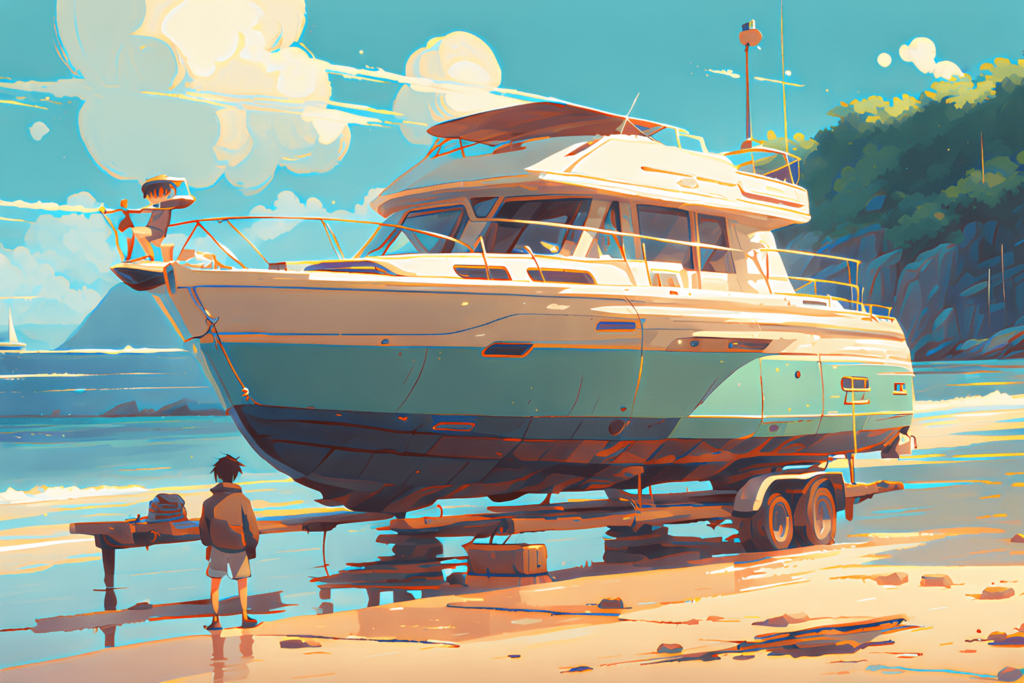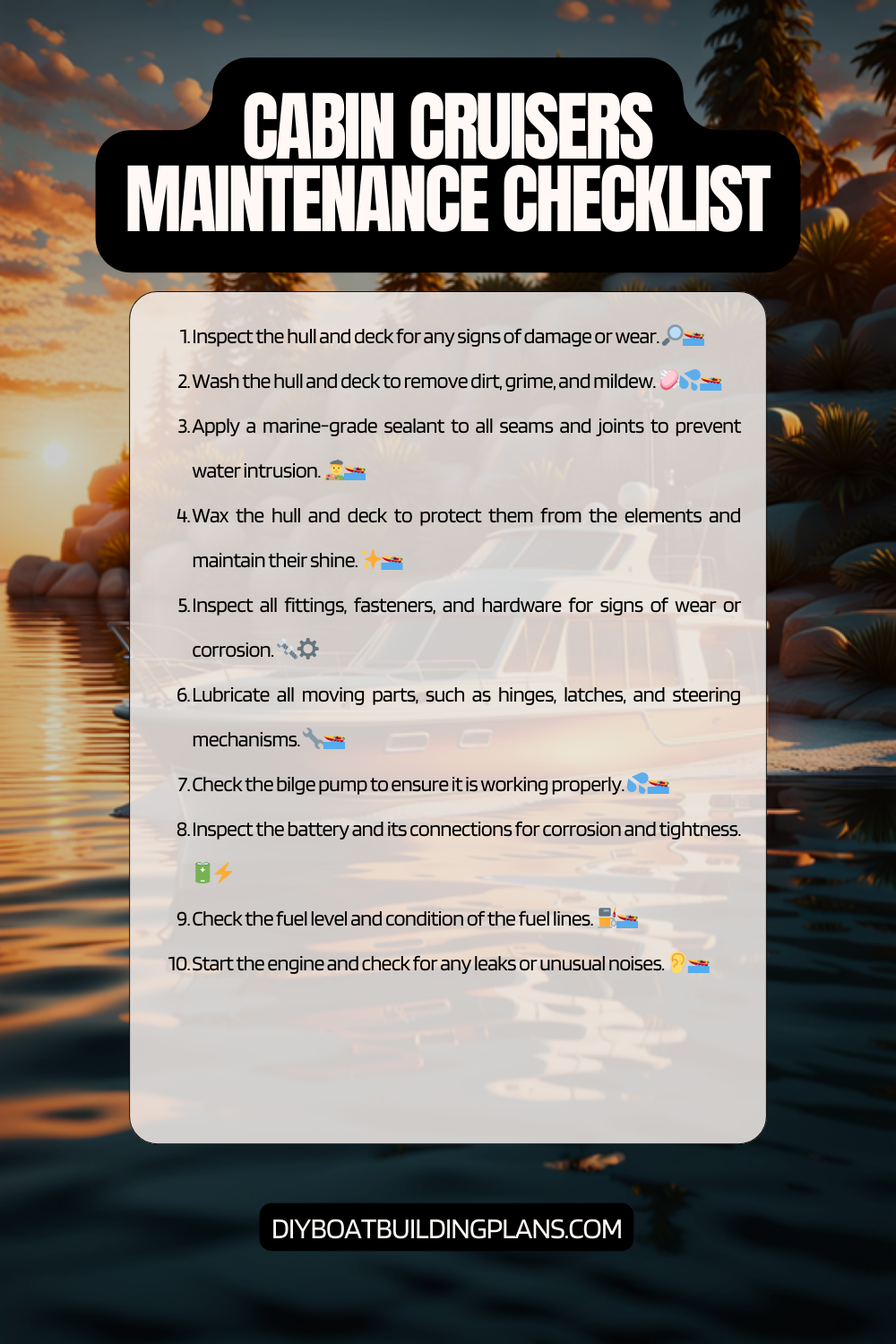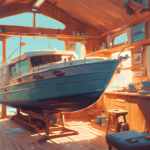Overview of Cabin Cruiser Maintenance Tips
Cabin cruisers are popular recreational boats that offer both comfort and functionality. These vessels are designed for extended stays on the water, with amenities such as sleeping quarters, a galley, and a bathroom. However, like any other type of boat, cabin cruisers require regular maintenance to ensure their optimal performance and longevity.
Key Takeaways
- Regular maintenance is crucial for the longevity and performance of your cabin cruiser.
- Pre-season maintenance checklist should include engine, electrical, hull, propeller, drive system, fuel system, interior, and exterior maintenance.
- Engine maintenance tips include checking oil levels, changing oil and filters, and inspecting belts and hoses.
- Hull maintenance and cleaning should be done regularly to prevent damage and maintain appearance.
- Winterization tips include draining all water systems, adding antifreeze, and storing the boat in a dry and secure location.

Importance of Regular Maintenance
Regular maintenance is crucial for cabin cruisers for several reasons. Firstly, it ensures the safety of everyone on board. By regularly inspecting and maintaining various components of the boat, potential issues can be identified and addressed before they become major problems. This includes checking the hull for any signs of damage or wear, inspecting the electrical system for any faulty wiring or connections, and testing the engine to ensure it is running smoothly.
Secondly, regular maintenance helps to extend the lifespan of the boat. By taking care of routine tasks such as changing the oil, inspecting belts and hoses, and cleaning the hull, cabin cruisers can continue to provide enjoyment for many years to come. Neglecting maintenance can lead to premature wear and tear, resulting in costly repairs or even the need for a new boat altogether.
Lastly, regular maintenance can save boat owners money in the long run. By addressing minor issues early on, they can be resolved before they escalate into major problems that require expensive repairs. Additionally, well-maintained boats tend to have better fuel efficiency, reducing overall operating costs.
Pre-Season Maintenance Checklist
Before launching your cabin cruiser for the season, it is important to complete a thorough pre-season maintenance checklist. This will help ensure that your boat is in top condition and ready for the water. Some tasks to include on your checklist are:
1. Check the battery: Inspect the battery for any signs of corrosion or damage. Clean the terminals if necessary and test the battery’s charge.
2. Inspect the hull: Look for any cracks, blisters, or other damage to the hull. Repair any issues before launching the boat.
3. Test the electrical system: Turn on all electrical components, such as lights, navigation systems, and radios, to ensure they are functioning properly.
4. Check safety equipment: Ensure that all required safety equipment, such as life jackets, fire extinguishers, and distress signals, are in good condition and easily accessible.
5. Inspect the trailer: If your cabin cruiser is stored on a trailer, inspect the trailer for any signs of wear or damage. Check the tires, brakes, and lights to ensure they are working properly.
By completing these tasks before launching your cabin cruiser for the season, you can help prevent any unexpected issues while out on the water.
Engine Maintenance Tips
| Tip | Description |
| Regular Oil Changes | Changing your engine oil regularly helps to keep your engine running smoothly and prevents wear and tear on engine components. |
| Check Fluid Levels | Regularly checking your engine’s fluid levels, such as coolant and transmission fluid, can help prevent engine damage and prolong the life of your engine. |
| Replace Air Filters | Replacing your engine’s air filter regularly can help improve engine performance and fuel efficiency. |
| Inspect Belts and Hoses | Checking your engine’s belts and hoses for wear and tear can help prevent engine damage and avoid costly repairs. |
| Keep Engine Clean | Keeping your engine clean can help prevent dirt and debris from building up and causing damage to engine components. |
The engine is one of the most important components of a cabin cruiser and requires regular maintenance to keep it running smoothly. Here are some engine maintenance tips to keep in mind:
1. Change the oil: Regularly change the engine oil according to the manufacturer’s recommendations. This helps to remove any contaminants and ensures proper lubrication of moving parts.
2. Check belts and hoses: Inspect the belts and hoses for any signs of wear or damage. Replace them if necessary to prevent any potential issues while out on the water.
3. Inspect the cooling system: Check the coolant level and inspect the cooling system for any leaks or blockages. Clean or replace the coolant if needed.
4. Maintain proper fuel quality: Use high-quality fuel and add a fuel stabilizer if your boat will be sitting idle for an extended period of time. This helps prevent fuel degradation and keeps the engine running smoothly.
By following these engine maintenance tips, you can help prolong the life of your cabin cruiser’s engine and avoid any unexpected breakdowns while out on the water.
Electrical System Maintenance
The electrical system of a cabin cruiser is responsible for powering various components, such as lights, navigation systems, and entertainment devices. Proper maintenance of the electrical system is essential for both safety and functionality. Here are some tips for maintaining the electrical system:
1. Check the battery: Regularly inspect the battery for any signs of corrosion or damage. Clean the terminals if necessary and ensure that the battery is securely fastened.
2. Inspect wiring and connections: Look for any loose or frayed wires, as well as any loose connections. Tighten or replace as needed to ensure proper electrical flow.
3. Test electrical components: Turn on all electrical components, such as lights, radios, and navigation systems, to ensure they are functioning properly. Replace any faulty components.
4. Protect against moisture: Cabin cruisers are exposed to water, so it is important to protect the electrical system from moisture. Use waterproof connectors and seal any exposed wiring.
By regularly maintaining the electrical system of your cabin cruiser, you can ensure that all components are functioning properly and reduce the risk of electrical issues while out on the water.
Hull Maintenance and Cleaning
The hull of a cabin cruiser is constantly exposed to water, which can lead to the growth of algae, barnacles, and other marine organisms. Regular cleaning and maintenance of the hull is important to prevent damage and maintain optimal performance. Here are some tips for hull maintenance and cleaning:
1. Wash the hull: Regularly wash the hull with a mild detergent and water to remove dirt, grime, and salt residue. Use a soft brush or sponge to avoid scratching the surface.
2. Wax the hull: Apply a high-quality boat wax to protect the hull from UV rays and minimize damage from exposure to water. Follow the manufacturer’s instructions for application.
3. Inspect for damage: Regularly inspect the hull for any signs of cracks, blisters, or other damage. Repair any issues promptly to prevent further damage.
4. Check the paint: If your cabin cruiser has a painted hull, check the paint for any signs of peeling or fading. Touch up or repaint as needed to maintain the appearance and protection of the hull.
By regularly cleaning and maintaining the hull of your cabin cruiser, you can help prevent damage and ensure optimal performance while out on the water.
Propeller and Drive System Maintenance
The propeller and drive system of a cabin cruiser are responsible for propelling the boat through the water. Regular maintenance of these components is important to ensure smooth operation and prevent any unexpected issues while out on the water. Here are some tips for propeller and drive system maintenance:
1. Check for damage: Inspect the propeller for any signs of damage, such as dents or bent blades. Replace the propeller if necessary to maintain optimal performance.
2. Lubricate moving parts: Regularly lubricate the moving parts of the drive system, such as the propeller shaft and bearings. This helps to reduce friction and extend the lifespan of these components.
3. Inspect the shaft and bearings: Check the propeller shaft and bearings for any signs of wear or damage. Replace them if necessary to prevent any potential issues while out on the water.
4. Clean debris: Remove any debris, such as seaweed or fishing line, from around the propeller and drive system. This helps to prevent clogs and maintain optimal performance.
By following these propeller and drive system maintenance tips, you can help ensure smooth operation and prevent any unexpected issues while enjoying your cabin cruiser on the water.
Fuel System Maintenance
The fuel system of a cabin cruiser is responsible for delivering fuel to the engine for combustion. Proper maintenance of the fuel system is important to ensure optimal performance and prevent any potential issues while out on the water. Here are some tips for fuel system maintenance:
1. Check the fuel tank: Regularly inspect the fuel tank for any signs of leaks or damage. Replace the tank if necessary to prevent any potential fuel leaks.
2. Inspect fuel lines: Look for any signs of wear or damage to the fuel lines. Replace them if necessary to prevent any potential fuel leaks or blockages.
3. Replace fuel filters: Regularly replace the fuel filters according to the manufacturer’s recommendations. This helps to remove any contaminants and ensure proper fuel flow.
4. Use high-quality fuel: Use high-quality fuel that is recommended for your cabin cruiser’s engine. This helps to prevent fuel system issues and maintain optimal performance.
By regularly maintaining the fuel system of your cabin cruiser, you can ensure proper fuel delivery to the engine and reduce the risk of any unexpected issues while out on the water.
Interior and Exterior Maintenance
In addition to maintaining the mechanical components of your cabin cruiser, it is also important to take care of the interior and exterior of the boat. This helps to maintain its appearance and functionality, as well as prolong its lifespan. Here are some tips for interior and exterior maintenance:
1. Clean upholstery: Regularly clean the upholstery with a mild detergent and water to remove dirt and stains. Use a soft brush or sponge to avoid damaging the fabric.
2. Inspect windows and hatches: Check the windows and hatches for any signs of leaks or damage. Repair or replace them if necessary to prevent any potential water intrusion.
3. Check the anchor and lines: Inspect the anchor and lines for any signs of wear or damage. Replace them if necessary to ensure proper anchoring while out on the water.
4. Protect against UV rays: Use UV protectant products on exterior surfaces, such as fiberglass, to prevent fading and damage from exposure to sunlight.
By regularly maintaining the interior and exterior of your cabin cruiser, you can ensure its optimal appearance, functionality, and longevity.
Download over 500 Boat Plans. Click on the link below.
-->Click Here<--
Winterization Tips
When the boating season comes to an end, it is important to properly winterize your cabin cruiser to protect it from the harsh winter conditions. Here are some tips for winterizing your boat:
1. Drain the water system: Completely drain the water system, including the freshwater tank, pipes, and hot water heater. This helps to prevent any potential freezing and damage to these components.
2. Add antifreeze: Add antifreeze to the plumbing system, including sinks, toilets, and showers. This helps to further protect against freezing and damage.
3. Stabilize the fuel: Add a fuel stabilizer to the fuel tank and run the engine for a few minutes to ensure that the stabilized fuel circulates throughout the system.
4. Store the boat properly: Store your cabin cruiser in a dry, covered area or use a boat cover to protect it from the elements. Ensure that it is securely fastened and protected from any potential damage.
By properly winterizing your cabin cruiser, you can protect it from the harsh winter conditions and ensure that it is ready for another season of boating.
Cabin Cruiser Maintenance Checklist

Conclusion – Cabin Cruiser Maintenance Tips
In conclusion, regular maintenance is essential for keeping a cabin cruiser in top condition. By following a pre-season maintenance checklist, maintaining the engine, electrical system, hull, propeller and drive system, fuel system, interior and exterior, and properly winterizing the boat, you can ensure its safety, longevity, and optimal performance. Regular maintenance not only saves you money in the long run but also provides peace of mind while out on the water. So take care of your cabin cruiser and enjoy many years of boating adventures!
FAQs – Cabin Cruiser Maintenance Tips
What is a cabin cruiser?
A cabin cruiser is a type of motorboat that is designed for leisure activities and has an enclosed cabin for sleeping and living.
Why is maintenance important for cabin cruisers?
Maintenance is important for cabin cruisers to ensure their safety, reliability, and longevity. Regular maintenance can prevent breakdowns, reduce repair costs, and extend the life of the boat.
What are some basic maintenance tasks for cabin cruisers?
Basic maintenance tasks for cabin cruisers include checking and changing the oil, inspecting and cleaning the propeller, checking and replacing the fuel filter, inspecting and cleaning the hull, and checking and replacing the battery.
How often should cabin cruisers be serviced?
Cabin cruisers should be serviced at least once a year, or more frequently if they are used frequently or in harsh conditions. It is important to follow the manufacturer’s recommended maintenance schedule.
What are some common problems with cabin cruisers?
Common problems with cabin cruisers include engine issues, electrical problems, leaks, and hull damage. Regular maintenance can help prevent these problems from occurring.
Can cabin cruiser maintenance be done by the owner?
Yes, many basic maintenance tasks for cabin cruisers can be done by the owner. However, more complex tasks may require the assistance of a professional mechanic or boat technician. It is important to follow the manufacturer’s instructions and safety guidelines when performing maintenance tasks.



